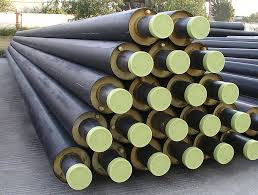views
The pre-insulated pipes market has emerged as a crucial solution for energy-efficient fluid transport in applications such as district heating and cooling, industrial piping, and renewable energy infrastructure. With the rising global focus on sustainability, energy efficiency, and resilient urban infrastructure, demand for pre-insulated piping systems has increased significantly. However, like many rapidly expanding markets, several external and internal threats can hinder the steady growth of the industry. From fluctuating raw material prices to regulatory challenges and technical barriers, these threats require strategic attention from manufacturers, developers, and policymakers to ensure the market’s long-term success.

Key Threats Impacting the Pre-Insulated Pipes Market
Despite the market's promising growth trajectory, several risks and challenges threaten to slow down or restrict adoption across various sectors and regions.
1. High Initial Investment and Installation Costs
One of the most significant threats to the pre-insulated pipes market is the high upfront cost associated with manufacturing, transporting, and installing these systems. Compared to conventional piping solutions, pre-insulated pipes involve additional costs due to advanced insulation materials, protective layers, and specialized jointing systems.
For municipalities, developers, and industries with limited budgets, these costs can deter investment, especially in emerging economies where infrastructure funding remains constrained. High installation expenses may also delay projects or lead to the selection of less energy-efficient alternatives.
2. Raw Material Price Volatility
The production of pre-insulated pipes relies heavily on raw materials such as steel, polyethylene, polyurethane (PUR), and polyisocyanurate (PIR) foams. Fluctuations in global raw material prices, driven by geopolitical tensions, supply chain disruptions, or inflationary pressures, directly impact manufacturing costs and market stability.
Price volatility increases operational risks for manufacturers, often leading to unpredictable pricing for end-users. These uncertainties can stall infrastructure projects or limit market competitiveness, particularly in cost-sensitive regions.
3. Environmental and Regulatory Pressures
While pre-insulated pipes contribute to energy efficiency, some materials used in their production raise environmental concerns, particularly non-recyclable or petrochemical-derived insulation components. Growing global emphasis on sustainability and stricter environmental regulations are putting pressure on manufacturers to transition to eco-friendly alternatives.
Compliance with evolving regulations increases production costs, requires material innovation, and may limit the use of certain products in highly regulated markets. Manufacturers slow to adapt to these changes risk losing market share or facing legal barriers.
4. Technical Complexity and Skills Gap
Installing pre-insulated piping systems requires technical expertise to ensure proper jointing, insulation integrity, and long-term performance. However, many regions, particularly in developing markets, face a shortage of skilled labor and technical know-how.
Poor installation practices can lead to performance failures, increased maintenance costs, and reduced system efficiency, damaging end-user confidence in pre-insulated piping solutions. The shortage of qualified installers remains a significant threat to market expansion, especially in emerging markets with ambitious infrastructure plans.
5. Competition from Alternative Solutions
The pre-insulated pipes market faces competition from alternative piping technologies and materials that offer lower upfront costs or simpler installation, albeit with lower energy efficiency. For budget-constrained projects, decision-makers may opt for cheaper alternatives, delaying market penetration for high-performance pre-insulated piping.
Additionally, innovations in other energy transport technologies, such as advanced district energy systems or decentralized renewable heating solutions, could reduce reliance on pre-insulated piping in specific applications, posing a long-term threat to market growth.
6. Market Fragmentation and Inconsistent Standards
The global pre-insulated pipes market remains fragmented, with varying product standards, material quality, and installation practices across regions. This inconsistency can result in poor system performance, reduced durability, and damage to the market's reputation.
Lack of unified industry standards also complicates international trade, project implementation, and product certification, limiting market scalability and adoption in certain regions.
Conclusion
The pre-insulated pipes market offers significant growth potential, driven by global infrastructure development, energy efficiency goals, and sustainable urban planning. However, threats such as high costs, raw material dependency, regulatory pressures, technical complexity, and market fragmentation present tangible risks to sustained market growth.
To mitigate these threats, industry stakeholders must focus on innovation in eco-friendly materials, invest in workforce training, develop cost-effective solutions, and promote global standardization efforts. Proactively addressing these challenges will help unlock the full potential of pre-insulated piping systems, supporting energy-efficient, resilient infrastructure for the future.



Comments
0 comment